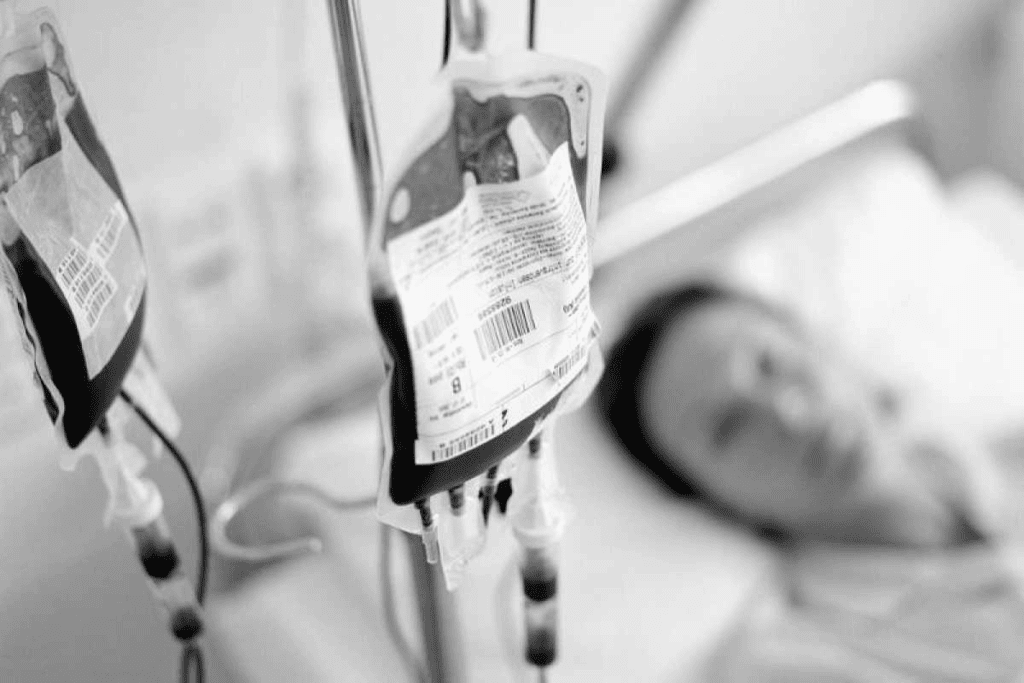Last Updated on November 25, 2025 by Ugurkan Demir

When you take anticoagulant medications to prevent blood clots or treat serious health issues, understanding the risks is essential. At Liv Hospital, we prioritize patient safety and make sure you’re informed about blood thinners side effects and how to manage them.
Anticoagulant medications, commonly known as blood thinners, help prevent strokes, heart attacks, and pulmonary embolisms. However, it’s important to recognize the potential blood thinners side effects. In this guide, we’ll explore the 12 main risks and symptoms linked to their use, helping you stay aware and proactive about your health.

Anticoagulant medications, also known as blood thinners, stop blood clots from forming or growing. They are key for people at risk of blood clots or with certain health conditions.
Blood thinners mess with the body’s clotting process. They aim to prevent blood clots or stop them from getting bigger. This is vital for those at risk of stroke, deep vein thrombosis (DVT), or pulmonary embolism.
These medications treat and prevent harmful blood clots. Knowing how they work helps patients manage their treatment better and lower risks.
The blood clotting process is complex, involving many clotting factors. It’s meant to stop bleeding when a blood vessel is injured. But sometimes, it leads to harmful blood clots.
Blood thinners disrupt this process. They either stop clotting factors from being made or block their activation. This prevents new clots or stops existing ones from growing. The table below shows how different blood thinners affect clotting.
| Type of Blood Thinner | Mechanism of Action | Effect on Clotting Process |
| Warfarin | Inhibits vitamin K-dependent clotting factors | Reduces clot formation by decreasing clotting factor production |
| Apixaban | Directly inhibits Factor Xa | Prevents clot formation by blocking a key clotting factor |
| Aspirin | Inhibits platelet aggregation | Reduces clot formation by preventing platelets from clumping |
Understanding blood thinners and their role in heart health helps patients stick to their treatment. This reduces risks.

Blood thinners are key for many patients. Knowing the different types is vital for good treatment. We’ll look at the various blood thinner categories, their uses, and how they differ.
Anticoagulants are a main type of blood thinner. They stop the body’s clotting process. Warfarin is widely used to prevent clots. But, it needs regular checks to be safe and work well.
Apixaban is newer and doesn’t need these checks. It’s easier for some patients. Heparin is used in hospitals for quick clot prevention.
These anticoagulants help with DVT, pulmonary embolism, and stroke in atrial fibrillation.
Antiplatelet medications stop platelets from clumping. Aspirin is well-known for preventing heart attacks and strokes. Clopidogrel and prasugrel are used after stent placement.
These drugs are key for those at risk of arterial clots. They’re often used with other treatments for heart disease.
It’s important to know the differences between anticoagulants and antiplatelet medications. Both prevent clots but in different ways. They’re used in different situations.
| Medication Type | Examples | Primary Use |
| Anticoagulants | Warfarin, Apixaban, Heparin | Preventing DVT, pulmonary embolism, stroke in atrial fibrillation |
| Antiplatelet Medications | Aspirin, Clopidogrel, Prasugrel | Preventing heart attacks and strokes in high-risk patients |
Knowing the different blood thinners helps healthcare providers tailor treatments. This improves outcomes and reduces risks for each patient.
Some medical conditions make it more likely for blood clots to form. Blood thinners are key in managing these conditions. They help prevent serious problems.
Deep Vein Thrombosis (DVT) is when a blood clot forms in deep veins, usually in the legs. If it breaks loose, it can go to the lungs and cause a pulmonary embolism. This is very dangerous. Blood thinners are vital in treating DVT and preventing pulmonary embolism by stopping the clot from growing and new ones from forming.
Key aspects of DVT and Pulmonary Embolism include:
Atrial fibrillation is a common heart rhythm disorder that raises stroke risk. Blood thinners are often given to people with atrial fibrillation to lower this risk. These medications thin the blood, preventing clots that can cause stroke.
Atrial fibrillation and stroke prevention are closely linked, as irregular heartbeat can lead to blood clot formation. Blood thinners are a key part of managing atrial fibrillation to reduce stroke risk.
Other than DVT and atrial fibrillation, some conditions also need blood thinners. These include mechanical heart valves, certain clotting disorders, and after specific surgeries. The choice to use blood thinners depends on the individual’s risk factors and medical history.
Other conditions that may require blood thinners include:
It’s important to understand these medical conditions and how blood thinners treat them. Healthcare providers work hard to find the right treatment for each patient. This is a delicate balance.
It’s important for patients and doctors to know about blood thinner risks. These medicines stop blood clots and save lives. But, they can also cause side effects.
Looking at the risks of blood thinners, we see common and rare side effects. The 12 main risks include bleeding, stomach problems, brain effects, and serious but rare issues.
Some things can make side effects from blood thinners worse. These include:
The type of blood thinner, your health, and other factors affect side effects. Common issues include:
While these side effects are serious, the benefits of blood thinners are often greater. For many, avoiding strokes and blood clots is more important than the treatment risks.
Patients on blood thinners face several risks, with bleeding complications being among the most critical. These complications can range from mild to life-threatening. We will discuss the first three risks associated with bleeding complications in this section.
One common bleeding complication is excessive or prolonged bleeding from cuts or injuries. Blood thinners make it harder for the body to form clots, leading to prolonged bleeding. This is a big problem for people with injuries or those who have surgery.
To manage this risk, patients should be careful with activities that may lead to cuts or injuries. Using protective gear, being mindful of sharp objects, and having a plan for emergencies can help.
Easy bruising and skin hemorrhages are signs of bleeding complications. The body’s clotting mechanism is impaired, causing blood to leak into the skin. This can result in bruises or purpura (purple spots on the skin). While often not serious, these symptoms can be unsightly and sometimes indicate a bigger issue.
Patients should watch their skin for unusual bruising or bleeding and report it to their healthcare provider. Adjustments to medication or additional treatments may be needed to manage these side effects.
Internal bleeding is a severe and potentially life-threatening complication. It’s important for patients to recognize the warning signs. These can include abdominal pain, vomiting blood, or passing black, tarry stools. Headaches, confusion, or weakness can also indicate internal bleeding in the brain or other critical areas.
If any of these symptoms occur, patients should seek immediate medical attention. Prompt treatment can significantly improve outcomes in cases of internal bleeding.
| Symptom | Description | Action |
| Excessive or Prolonged Bleeding | Bleeding that doesn’t stop after 10-15 minutes | Apply pressure, seek medical help if necessary |
| Easy Bruising | Unexplained bruises or purpura | Monitor, report to healthcare provider |
| Internal Bleeding | Abdominal pain, vomiting blood, black stools | Seek immediate medical attention |
Understanding these risks and being vigilant about the signs and symptoms can help patients on blood thinners manage their condition more effectively. This can reduce the risk of serious complications.
Patients on blood thinners should know about possible gastrointestinal side effects. These can range from mild discomfort to serious problems. We will look at the next three risks related to these side effects.
Diarrhea is a common side effect of some blood thinners. Anticoagulant medications can upset the balance of gut bacteria. This can cause digestive problems. If you have persistent diarrhea, talk to your healthcare provider to check for any underlying issues.
To help with diarrhea, drink lots of fluids. You might need to change your diet or take extra medications to feel better.
Stomach pain and nausea are also side effects of blood thinners. These can happen due to stomach irritation or other issues with anticoagulant therapy. If you have severe or ongoing stomach pain, get medical help right away.
To lessen stomach discomfort, take your medication with food or adjust your dosage schedule. But, any changes should be made with your healthcare provider’s advice.
Gastrointestinal bleeding is a serious risk with blood thinners. Symptoms include black, tarry stools or vomiting blood. If you see these signs, seek immediate medical attention.
GI bleeding is very dangerous and needs quick treatment. It’s key to watch your condition and tell your healthcare provider about any unusual symptoms.
In summary, gastrointestinal side effects are a big concern for those on blood thinners. By knowing the risks and taking steps to prevent them, you can stay safe and comfortable during treatment.
Blood thinners are key in preventing strokes and heart problems. But, they can also cause neurological and sensory side effects. These issues can worry patients and need careful handling.
Dizziness is a common side effect of blood thinners. It can feel like you’re lightheaded or have vertigo, making it hard to balance. It’s important to keep an eye on your blood pressure and tell your doctor if you’re always dizzy.
A study in the Journal of Clinical Hypertension showed more dizziness in patients on blood thinners. The exact reason is not known, but changes in blood flow and pressure might play a part.
Some people on blood thinners might get headaches or see things differently. These can be mild or severe, like migraines, and vision changes can blur or double vision. It’s key to tell if these headaches and vision changes are from the medication or something more serious.
| Symptom | Possible Causes | Action |
| Mild Headaches | Medication side effect, dehydration | Stay hydrated, consult doctor if persistent |
| Severe Headaches | Bleeding, other underlying conditions | Seek immediate medical attention |
| Vision Changes | Medication effect, underlying conditions | Consult an eye specialist, report to doctor |
Some patients on blood thinners might feel confused or have memory problems. It’s not always clear why, but the medication and the health issues it treats might play a role.
“The use of anticoagulants has been associated with cognitive decline in some patients, though the mechanisms are not fully understood.”
If you’re experiencing these cognitive effects, talk to your doctor. They might need to adjust your medication or offer other support.
Rare but serious side effects can happen with blood thinners. It’s key to know about these risks. Anticoagulant meds are usually safe but can have serious complications that need quick medical help.
Skin necrosis is a rare but serious issue. It happens when skin tissue dies because it doesn’t get enough blood. This is more common with certain meds, like warfarin, at the start of treatment. Symptoms include severe pain, skin discoloration, and ulcers. If not treated, it can cause big tissue damage and might need surgery.
Severe allergic reactions to blood thinners are rare but can be deadly. Symptoms include trouble breathing, fast heartbeat, and low blood pressure. Patients might also get hives, itch, and swell, mainly in the face, lips, tongue, or throat. If you see these signs, get medical help right away.
Some blood thinners can harm the bone marrow, causing low blood counts. This can lead to anemia, more infections, and bleeding problems. Symptoms may include fatigue, pale skin, and frequent infections. It’s important to have regular blood tests to check counts and adjust treatment if needed.
In summary, while rare, these serious side effects can have big consequences. It’s vital for patients to know about these risks and work closely with their doctors to avoid complications.
Blood thinners can interact with many medications and foods, raising the risk of side effects. It’s key for patients to know about these interactions to manage their treatment well.
Some drugs can make blood thinners work too well, increasing the risk of bleeding. These include:
It’s important for patients to tell their doctors about all the medications they’re taking to avoid bad interactions.
Vitamin K in foods is key for blood thinners like warfarin to work right. Foods high in Vitamin K can fight the effects of warfarin. So, it’s important to eat these foods in a steady amount.
| Food | Vitamin K Content (mcg per serving) |
| Spinach (1 cup cooked) | 540 |
| Kale (1 cup cooked) | 443 |
| Broccoli (1 cup cooked) | 220 |
| Green tea (1 cup brewed) | 1-2 |
People on warfarin should watch their Vitamin K intake. They should try to eat the same amount of these foods to keep their INR levels steady.
Some health issues can make side effects from blood thinners worse. These include:
People with these conditions need to be closely watched. They might need their blood thinner doses changed to lower risks.
Knowing about drug interactions, diet, and health conditions can help patients manage their blood thinner treatment better. This can reduce the chance of bad side effects.
Blood thinners are lifesaving but need careful watching to avoid side effects. Managing them well means regular doctor visits, making lifestyle changes, and learning about your treatment.
Testing regularly is key for blood thinner users. International Normalized Ratio (INR) tests help check if the meds are working right. It’s important to see your doctor often to tweak doses and talk about any issues.
Your doctor will check your health and look for signs of bleeding or other side effects. Always tell your doctor about any health changes or new symptoms.
Some lifestyle changes can lower the risks of blood thinner side effects. Sticking to a consistent diet is important, as foods rich in vitamin K can affect your INR levels. Try to eat a balanced diet and avoid big changes in your vitamin K intake.
Also, cut down on alcohol as too much can raise your bleeding risk. Exercise is good, but avoid sports or activities that might cause injuries.
Knowing when to get help fast is vital when on blood thinners. Severe bleeding like heavy nosebleeds, vomiting blood, or bad headaches needs quick action. Also, seek emergency care if you feel dizzy, confused, or have severe stomach pain.
Being aware of these side effects and knowing how to handle them can greatly improve your life on blood thinners. Always talk to your doctor if you have any worries about your treatment.
We’ve looked at how blood thinners help prevent and treat serious health issues. These include deep vein thrombosis, pulmonary embolism, and stroke. Yet, these medicines can also have side effects that need attention.
The good news is that blood thinners save lives, mainly for those at risk of heart problems. Knowing the risks helps people take steps to avoid bad reactions and get the most from their treatment.
For safe treatment, patients must stay in touch with their doctors. This means regular tests, check-ups, and making healthy lifestyle choices. These actions can reduce the chance of side effects.
By understanding both the benefits and risks of blood thinners, we can help patients get the best results. It’s all about knowing the medicines, their possible side effects, and the need for careful management.
Blood thinners, also known as anticoagulant medications, help prevent blood clots. They treat conditions like deep vein thrombosis, stroke, and atrial fibrillation.
There are two main types. Anticoagulants, such as warfarin and apixaban, and antiplatelet medications, like aspirin.
They interfere with the blood clotting process. This prevents blood clots from forming.
Risks include bleeding complications and side effects like gastrointestinal issues. There are also rare but serious adverse reactions.
Symptoms include excessive bleeding, easy bruising, and internal bleeding signs.
Yes, they can cause diarrhea, stomach pain, and nausea. There’s also a risk of GI bleeding.
Side effects include dizziness, headaches, and vision changes. There can also be cognitive effects and confusion.
Yes, rare reactions include skin necrosis, severe allergic reactions, and low blood counts.
Manage side effects with regular testing and medical follow-ups. Make lifestyle adjustments and know when to seek emergency care.
Yes, some medications can interact with blood thinners. This can enhance their effects or increase side effects.
Yes, dietary considerations like vitamin K intake can affect blood thinner efficacy.
Yes, certain health conditions can increase the risk of side effects from blood thinners.
Subscribe to our e-newsletter to stay informed about the latest innovations in the world of health and exclusive offers!